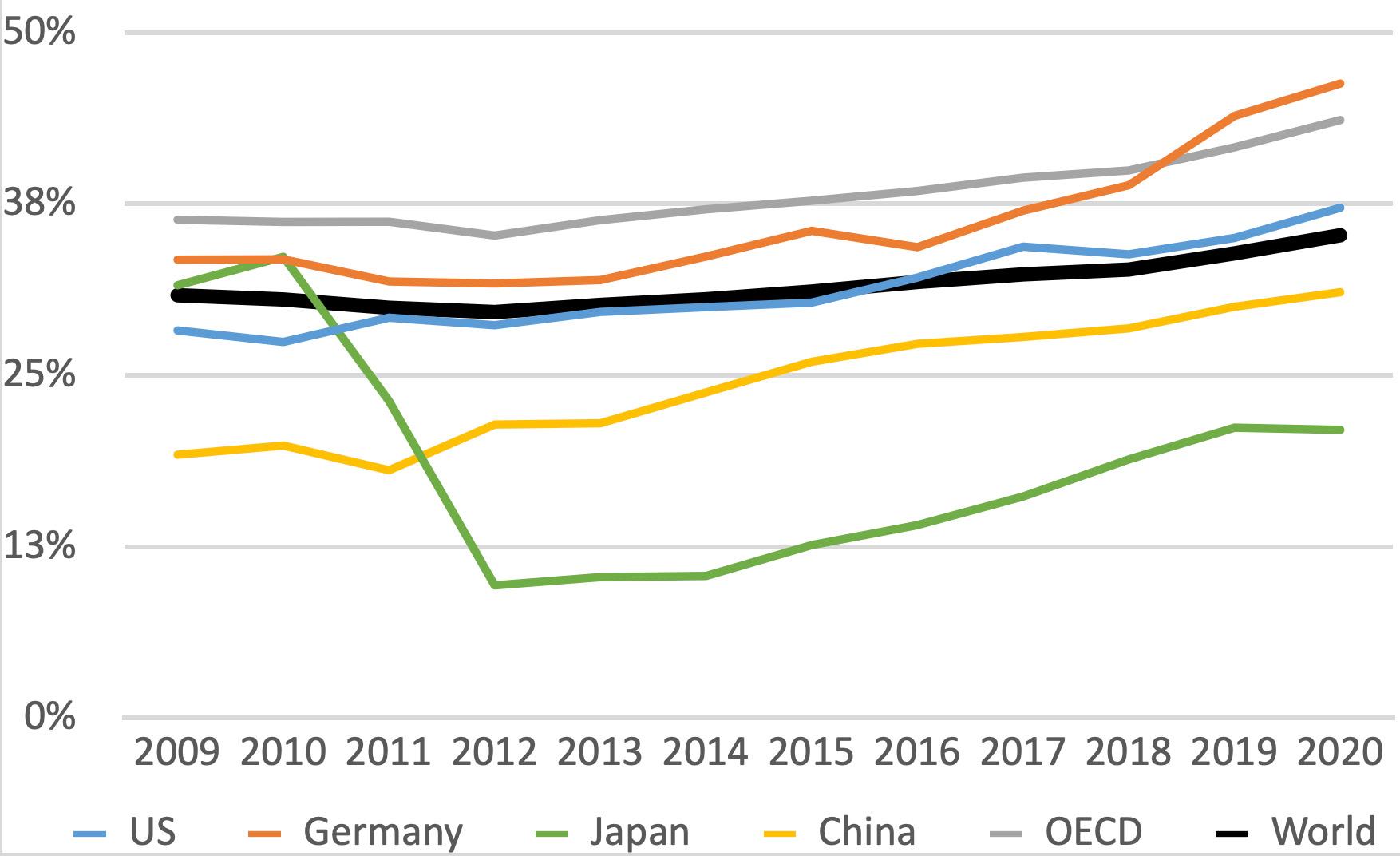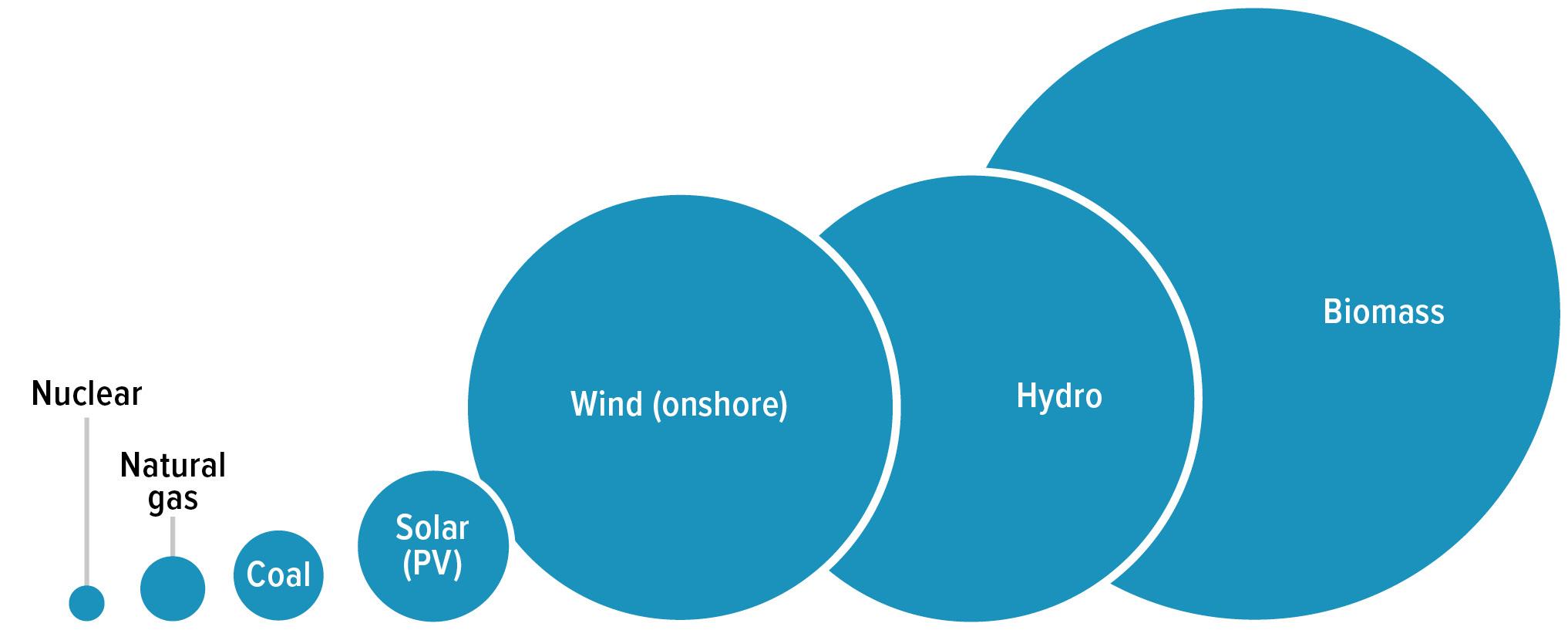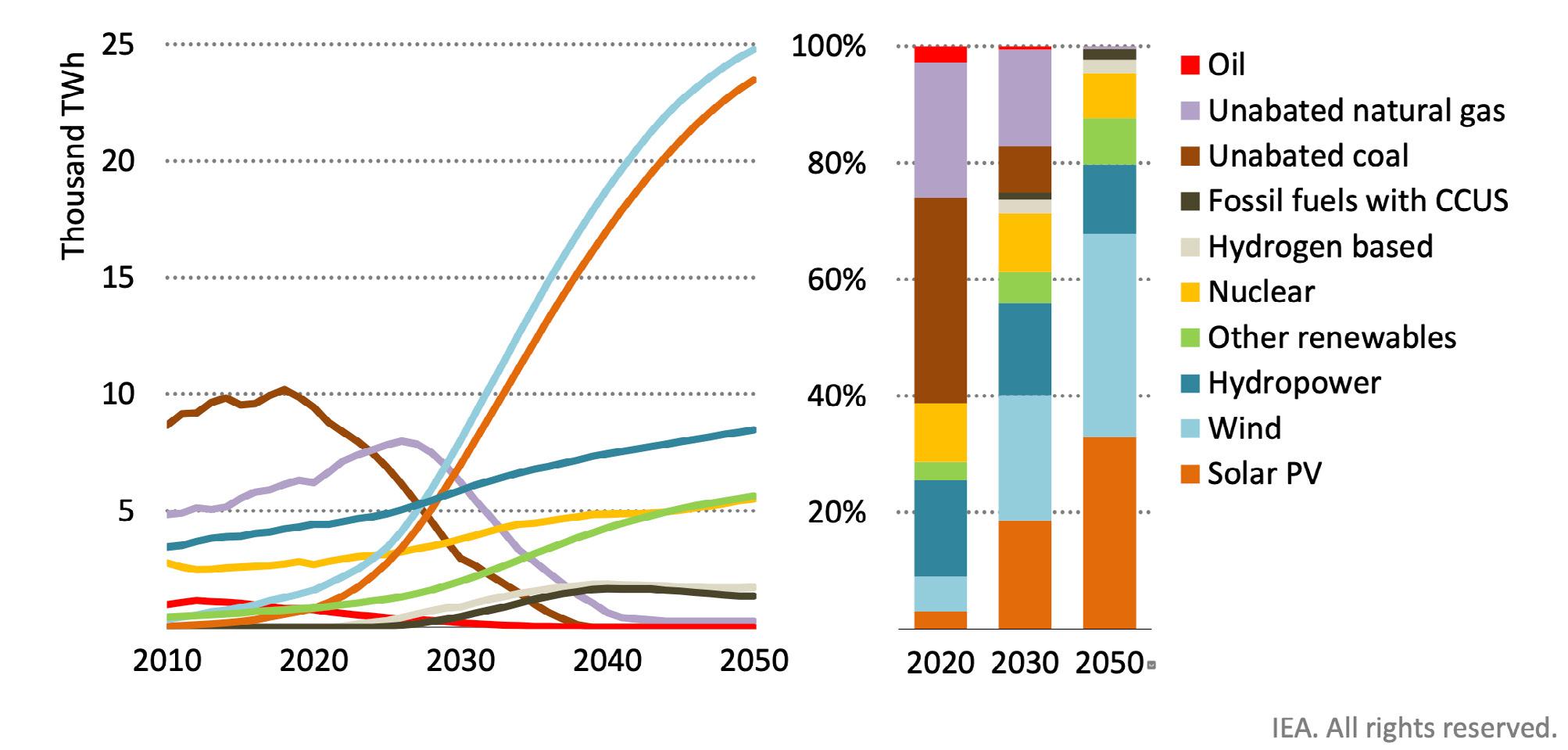
9 minute read
III. Implications for the United States
Decarbonization in the United States
In the United States, carbon-dioxide emissions from electric power have declined substantially in recent years, due to the substitution of gas-fired generation for coal-fired generation. Between 2005 and 2019, the share of generation from coal declined from 50 percent to 23 percent, while the share from gas increased from 19 percent to 38 percent, and carbon-dioxide emissions from the power sector fell by 32 percent.66 Growth in generation from renewable sources has accelerated, with generation from wind power almost doubling in the five years through 2020, and generation from solar almost quadrupling (see Figure 5, US Electric Generation by Fuel).67
With vast land areas, including plains with consistent winds and deserts with consistent sunlight, the United States enjoys an enormous potential for renewable generation. The technical potential for US renewable generation is tens to hundreds of times larger than its current electric demand.68 Many studies have been done of the potential to decarbonize electric generation and overall energy supply in the United States. A review by the US National Academies of Sciences, Engineering and Medicine (NASEM) concluded that five near-
Figure 5: US Electric Generation by Fuel
SOURCE: “U.S. ENERGY-RELATED CARBON DIOXIDE EMISSIONS, 2020,” US ENERGY INFORMATION ADMINISTRATION, DECEMBER 22, 2021, HTTPS://WWW.EIA.GOV/ENVIRONMENT/EMISSIONS/CARBON.
66 “Electric Power Sector CO2 Emissions Drop as Generation Mix Shifts from Coal to Natural Gas,” US Energy Information Administration, June 9, 2021, https://www.eia.gov/todayinenergy/detail.php?id=48296. Over that time period, renewable generation (including conventional hydroelectric) grew from 9 percent to 18 percent, driven primarily by increased wind generation, while nuclear generation held steady at 20 percent. Total generation was relatively constant. 67 “Monthly Energy Review,” US Energy Information Administration, table 7.2A, https://www.eia.gov/totalenergy/data/browser/index.php?tbl=T07.02A#/?f=A&start=1949&end=2020&charted=8-10-11-12-13-14. 68 Anthony Lopez, et al., “U.S. Renewable Energy Technical Potentials: A GIS-Based Analysis,” National Renewable Energy Laboratory, July 2012, https://www.nrel.gov/ docs/fy12osti/51946.pdf. Total US power generation averages around 4,000 terawatt-hours (TWh); in this report the technical wind potential was estimated at about 50,000 TWh and the technical solar potential at over 280,000 TWh; the estimate would likely be higher today due to improvements in the technologies.
term actions were common to the approaches in the studies they reviewed, including:
1. improve energy efficiency;
2. electrify energy requirements for transportation, buildings, and industry;
3. decarbonize electricity production, including deployment of wind and solar generation at a fast pace (matching or exceeding record historical levels) and continued or accelerated retirement of coal generation;
4. improve infrastructure, including electric transmission capacity (increasing it by as much as 60 percent by 2030), electric-vehicle charging capacity, and CO2 transport and storage (for carbon capture);
5. ongoing research and development (R&D) in several areas to expand technical options, such as for advanced nuclear energy and other zero-carbon dispatchable generation, hydrogen production, and zero-carbon options for shipping and industry.69
The NASEM review found that the studies generally incorporated increases in clean electric generation from 37 percent in 2020 to as much as 75 percent by 2030, including the addition of 250–350 GW each of wind and solar generation, with clean generation reaching 85 percent or more by 2050. Other studies have also highlighted the variety of scenarios through which US energy decarbonization could be achieved, and the wide range of electric generation and other technologies likely to be required to do so.70
Challenges to Deployment of Renewable Energy
Despite the extensive resource base and the potential for renewable generation to provide the foundation for a decarbonized power system, expansion of renewable generation in the United States at the pace anticipated in decarbonization projections may be challenging. While renewable generation is attractive in the abstract, it is distributed over large land areas and, therefore, can have a widespread impact on communities.71 Wind power has generated local opposition throughout the Midwest, and solar projects have faced opposition in both western deserts and eastern farmlands.72
Although the United States has extensive renewable resources, they are widely dispersed, and the best resources are distant from energy demand (see Figure 6). One study found that about 90 percent of US wind power potential, and almost 60 percent of its solar-power potential, was in the fifteen-state region between the Mississippi River and the Rocky Mountains, but that 70 percent of electric demand would be from outside that region.73 As a result, increasing reliance on renewable energy may also require greatly expanding electric transmission. One major study of US decarbonization options projected that transmission capacity would need to more than triple by 2050.74 Expanding transmission capacity is often challenging because of the impact on the landscape and communities all along the routes. Transmission expansion is particularly difficult in the United States because it requires state-by-state approvals and can face resistance from entrenched interests, and a number of long-distance transmission projects to support renewable generation have been unsuccessful.75
69 “Accelerating Decarbonization of the U.S. Energy System,” National Academies of Sciences, Engineering, and Medicine, 2021, https://www.nap.edu/catalog/25932/accelerating-decarbonization-of-the-us-energy-system. 70 Lindsey Walter, Lesley Jantarasami, and Conrad Schneider, “Pathways to Net-Zero Emissions,” Decarb America, February 4, 2021, https://decarbamerica.org/report/pathways-to-net-zero-emissions. 71 Samantha Gross, “Renewables, Land Use, and Local Opposition in the United States,” Brookings, January 2020, https://www.brookings.edu/research/renewables-land-use-and-local-opposition-in-the-united-states/. 72 Emily Pontecorvo, “We Need to Build a Lot of Wind Turbines. Will Americans Agree to Live Near Them?” Grist, January 22, 2021, https://grist.org/energy/we-need-to-build-a-lot-of-wind-turbines-will-americans-agree-to-live-near-them/. 73 Alexandra Rekkas, “Transmission Upgrades & Expansions: Keys to Meeting Large Customer Demand for Renewable Energy,” David Gardiner and Associates, January 16, 2018, https://www.dgardiner.com/wef-dga-report-transmission-needed-meet-corporate-americas-growing-demand-renewable-power/. 74 “Net-Zero America,” Princeton University, https://netzeroamerica.princeton.edu/. 75 Robinson Meyer, “Unfortunately, I Care About Power Lines Now,” Atlantic, July 28, 2021, https://www.theatlantic.com/science/archive/2021/07/america-is-bad-at-building-power-lines-lets-fix-that-transmission-climate/619591/. Russell Gold, “Building the Wind Turbines Was Easy. The Hard Part Was Plugging Them In,” Wall Street Journal, June 22, 2019, https://www.wsj.com/articles/building-the-wind-turbines-was-easy-the-hard-part-was-plugging-them-in-11561176010; “Maine Voters Reject Quebec Hydropower Transmission Line,” Reuters, November 3, 2021, https://www.reuters.com/world/americas/maine-voters-reject-quebec-hydropower-transmission-line-2021-11-03/.
Of course, there is much policy interest in addressing the challenges to deploying renewable energy and expanding transmission capacity at the pace required to achieve decarbonization goals. These challenges also place a premium on ensuring other low-carbon-generating options, including nuclear power, continue to be developed and considered, so the pace of decarbonization can achieve climate-preservation objectives.
Nuclear Power in the United States
Nuclear power has consistently provided the greatest share of zero-carbon electricity in the United States (see Figure 7). Through research, testing, and experience, existing US power plants have also improved their operations, both increasing their capacity factor (the percentage of output available throughout the year) and implementing power uprates, both of which enable increased zero-carbon generation from existing assets.76 However, existing nuclear-power generation in the United States faces economic challenges driven by additions of natural gas and renewable generating capacity, the rules governing electric markets, and, until recently, historically low natural-gas prices. More than 8,400 megawatts of nuclear generation have retired prematurely since 2013.77 In April 2022, the US Department of Energy began seeking applications for the $6-billion Civil Nuclear Credit Program, which was authorized and funded under the Bipartisan Infrastructure Law, to preserve the clean energy from existing nuclear power plants.78 The Inflation Reduction Act includes tax credits that will support existing reactors as well as provide incentives for new advanced nuclear energy options.
Figure 6: The Best US Renewable Resources Are Distant from Many Population Centers

SOURCE: “INTERCONNECTIONS SEAM STUDY,” NATIONAL RENEWABLE ENERGY LABORATORY, HTTPS://WWW.NREL.GOV/ANALYSIS/SEAMS.HTML.
Reprinted with permission from the National Renewable Energy Laboratory, https://www.nrel.gov/docs/fy21osti/78161.pdf, accessed September 19, 2022. The figure appears on page 11 of this linked publication and will be a cleaner citation than pointing to the web page which could change.
Please note that the NREL developed figure is not to be used to imply an endorsement by NREL, the Alliance for Sustainable Energy, LLC, the operator of NREL, or the US Department of Energy.
76 “U.S. Nuclear Industry Capacity Factors,” Nuclear Energy Institute, https://www.nei.org/resources/statistics/us-nuclear-industry-capacity-factors; “U.S. Nuclear Industry Yearly Power Uprates and Capacity Additions,” Nuclear Energy Institute, https://www.nei.org/resources/statistics/us-industry-yearly-uprates-and-capacity-additions. 77 Stephen S. Greene, Advancing US-ROK Cooperation on Nuclear Energy, Atlantic Council, March 2, 2021, https://www.atlanticcouncil.org/in-depth-research-reports/report/advancing-us-rok-cooperation-on-nuclear-energy/. 78 “DOE Seeks Applications, Bids for $6 Billion Civil Nuclear Credit Program,” US Department of Energy, press release, April 19, 2022, https://www.energy.gov/articles/doe-seeks-applications-bids-6-billion-civil-nuclear-credit-program.
While gigawatt-scale conventional nuclear reactors continue to be constructed around the world (e.g., in Russia, China, South Korea, and the United Arab Emirates), the future of nuclear power in the United States appears to be focused on advanced nuclear technologies. A recent study concluded that advanced nuclear technologies could provide 20 to 50 percent of US electric generation by 2050.79
The US government supports advanced nuclear technologies, most visibly through the Department of Energy’s ARDP. This program has awarded partial funding—expected to total more than $3 billion—for two demonstration projects expected to result in operating reactors within seven years.80 The program has also awarded funding in smaller increments for “risk reduction” projects and advanced-reactor concept work on designs that could be demonstrated over a longer time period.81 In addition to the ARDP and the tax credits included in the Inflation Reduction Act, which provide incentives for nuclear energy on par with those previously offered to renewables, several legislative efforts have been taken to support advanced nuclear energy. These include provisions in the Energy Act of 2020 to support fuel availability for advanced reactors and research, development, demonstration, and commercialization programs for nuclear energy, and the reintroduction of the American Nuclear Infrastructure Act (ANIA), which would authorize the Nuclear Regulatory Commission (NRC) to support international nuclear regulatory cooperation, support licensing of advanced reactors, and update ownership provisions for nuclear reactors to permit investment from entities in allied countries.82
The administration’s efforts explicitly include nuclear power as part of the approach to decarbonization. Financial incentives for nuclear power are part of the legislative efforts supporting the decarbonization agenda, and Secretary of Energy Jennifer Granholm has said, “Carbon-free nuclear power is an absolutely critical part of our decarbonization equation.”83

Key sources of carbon-free electric generation in the United States as a fraction of total generation. Excludes biomass and geothermal generation.
SOURCE DATA: “STATISTICAL REVIEW OF WORLD ENERGY,” BP, 2021, HTTPS://WWW.BP.COM/EN/GLOBAL/CORPORATE/ENERGY-ECONOMICS/STATISTICAL-REVIEW-OF-WORLD-ENERGY.HTML.
79 Adam Stein, Jonah Messinger, Seaver Wang, Juzel Lloyd, Jameson McBride, and Rani Franovich, "Advancing Nuclear Energy: Evaluating Deployment, Investment, and Impact in America's Clean Energy Future," The Breakthrough Institute, July 2022, https://thebreakthrough.org/articles/advancing-nuclear-energy-report. 80 “U.S. Department of Energy Announces $160 Million in First Awards under Advanced Reactor Demonstration Program,” US Department of Energy, press release, October 13, 2020, https://www.energy.gov/ne/articles/us-department-energy-announces-160-million-first-awards-under-advanced-reactor. 81 “Advanced Reactor Demonstration Program,” US Department of Energy, https://www.energy.gov/ne/advanced-reactor-demonstration-program. 82 “Advanced Reactors in the Energy Act of 2020 and the New Administration,” Nuclear Innovation Alliance, January 2021, https://nuclearinnovationalliance.org/advanced-reactors-energy-act-2020-and-new-administration; Amy Roma and Stephanie Fishman, “American Nuclear Infrastructure Act Makes a 2021 Comeback,” Hogan Lovells, July 20, 2021, https://www.hlnewnuclear.com/2021/07/american-nuclear-infrastructure-act-makes-a-2021-comeback/. 83 “USA Needs Nuclear to Achieve Net Zero, Says Granholm,” World Nuclear News, June 17, 2021, https://www.world-nuclear-news.org/Articles/USA-needs-nuclear-to-achieve-net-zero-says-Granhol.





